Nonverbal Communication and Its Impact on Business Success
VerifiedAdded on 2023/01/12
|6
|1199
|70
Report
AI Summary
This report examines the multifaceted role of nonverbal communication within the business environment. It delves into various modes of expression, including posture, eye contact, gestures, and the impact of clothing and adornment. The paper emphasizes the significance of understanding nonverbal cues in interactions with colleagues, customers, and competitors. It explores how nonverbal communication functions to guide employees, convey information, and influence perceptions, highlighting examples such as crossed arms or a firm handshake. The report also details the benefits of nonverbal interaction, such as enhancing cooperation, conveying confidence, and facilitating communication in global business settings. Furthermore, it examines the effectiveness of different methods, including eye contact and gestures, and their impact on business operations. The conclusion stresses the importance of nonverbal communication for successful business relationships, underscoring that maintaining eye contact and adopting the right posture during conversations are essential for improving business outcomes.
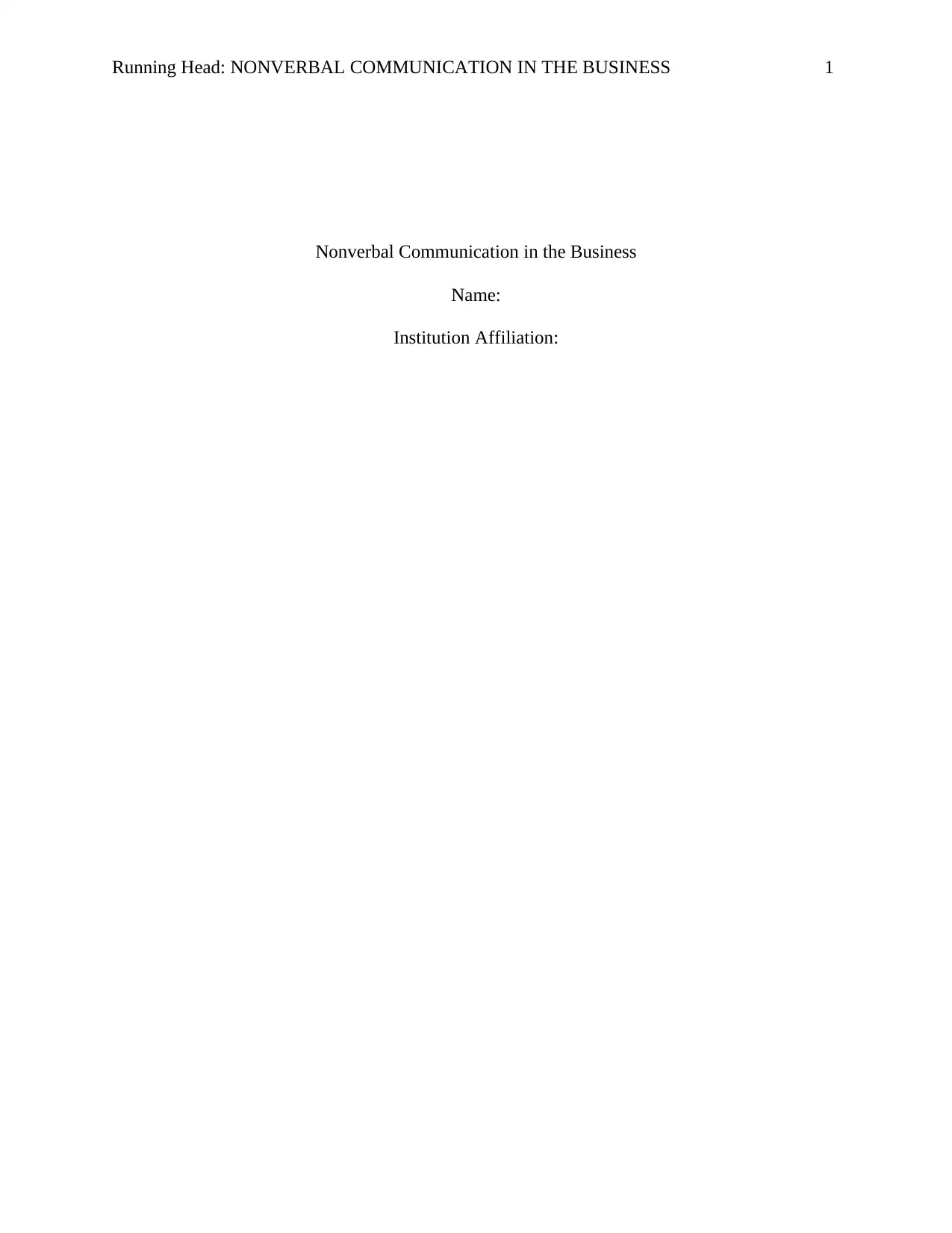
Running Head: NONVERBAL COMMUNICATION IN THE BUSINESS 1
Nonverbal Communication in the Business
Name:
Institution Affiliation:
Nonverbal Communication in the Business
Name:
Institution Affiliation:
Paraphrase This Document
Need a fresh take? Get an instant paraphrase of this document with our AI Paraphraser
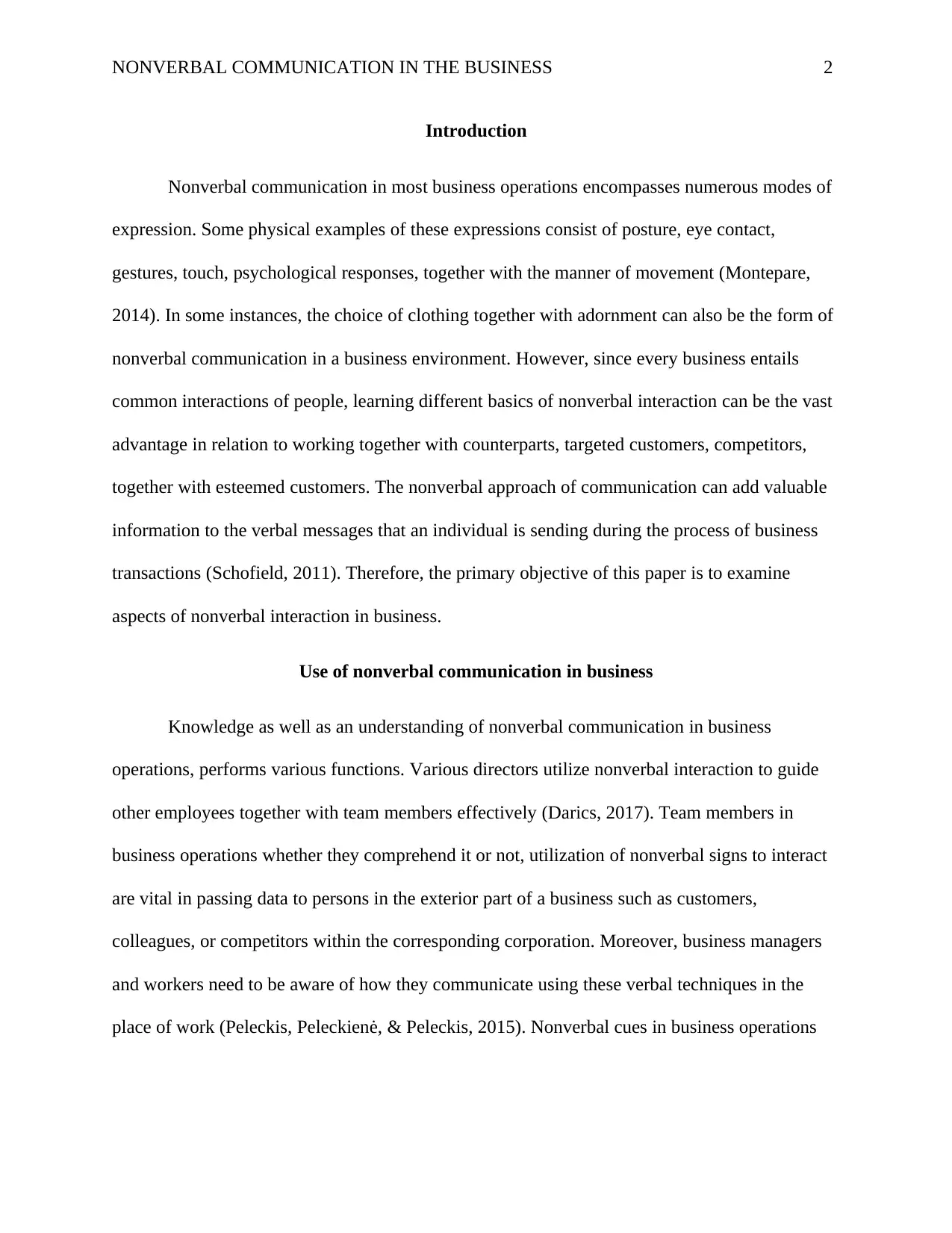
NONVERBAL COMMUNICATION IN THE BUSINESS 2
Introduction
Nonverbal communication in most business operations encompasses numerous modes of
expression. Some physical examples of these expressions consist of posture, eye contact,
gestures, touch, psychological responses, together with the manner of movement (Montepare,
2014). In some instances, the choice of clothing together with adornment can also be the form of
nonverbal communication in a business environment. However, since every business entails
common interactions of people, learning different basics of nonverbal interaction can be the vast
advantage in relation to working together with counterparts, targeted customers, competitors,
together with esteemed customers. The nonverbal approach of communication can add valuable
information to the verbal messages that an individual is sending during the process of business
transactions (Schofield, 2011). Therefore, the primary objective of this paper is to examine
aspects of nonverbal interaction in business.
Use of nonverbal communication in business
Knowledge as well as an understanding of nonverbal communication in business
operations, performs various functions. Various directors utilize nonverbal interaction to guide
other employees together with team members effectively (Darics, 2017). Team members in
business operations whether they comprehend it or not, utilization of nonverbal signs to interact
are vital in passing data to persons in the exterior part of a business such as customers,
colleagues, or competitors within the corresponding corporation. Moreover, business managers
and workers need to be aware of how they communicate using these verbal techniques in the
place of work (Peleckis, Peleckienė, & Peleckis, 2015). Nonverbal cues in business operations
Introduction
Nonverbal communication in most business operations encompasses numerous modes of
expression. Some physical examples of these expressions consist of posture, eye contact,
gestures, touch, psychological responses, together with the manner of movement (Montepare,
2014). In some instances, the choice of clothing together with adornment can also be the form of
nonverbal communication in a business environment. However, since every business entails
common interactions of people, learning different basics of nonverbal interaction can be the vast
advantage in relation to working together with counterparts, targeted customers, competitors,
together with esteemed customers. The nonverbal approach of communication can add valuable
information to the verbal messages that an individual is sending during the process of business
transactions (Schofield, 2011). Therefore, the primary objective of this paper is to examine
aspects of nonverbal interaction in business.
Use of nonverbal communication in business
Knowledge as well as an understanding of nonverbal communication in business
operations, performs various functions. Various directors utilize nonverbal interaction to guide
other employees together with team members effectively (Darics, 2017). Team members in
business operations whether they comprehend it or not, utilization of nonverbal signs to interact
are vital in passing data to persons in the exterior part of a business such as customers,
colleagues, or competitors within the corresponding corporation. Moreover, business managers
and workers need to be aware of how they communicate using these verbal techniques in the
place of work (Peleckis, Peleckienė, & Peleckis, 2015). Nonverbal cues in business operations
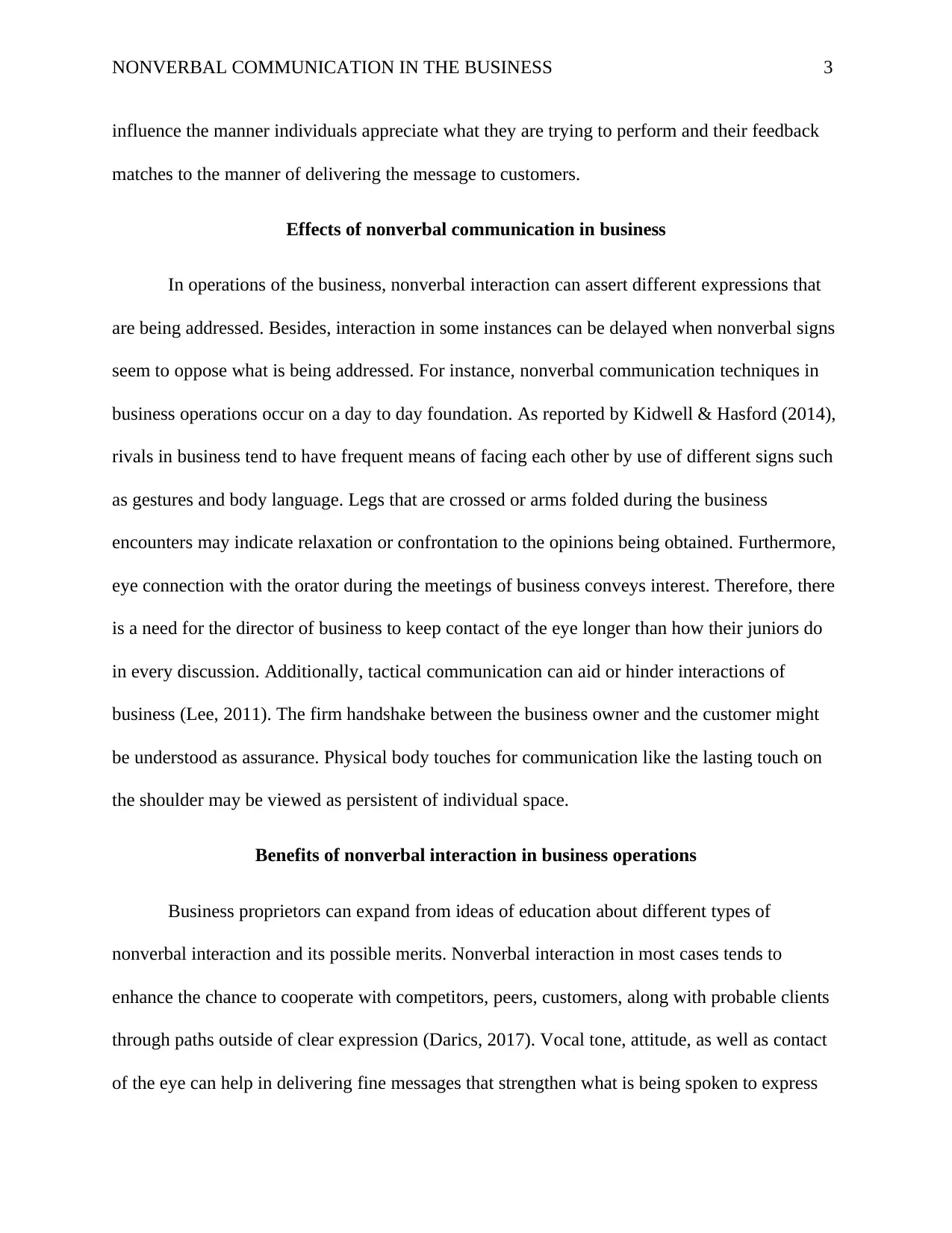
NONVERBAL COMMUNICATION IN THE BUSINESS 3
influence the manner individuals appreciate what they are trying to perform and their feedback
matches to the manner of delivering the message to customers.
Effects of nonverbal communication in business
In operations of the business, nonverbal interaction can assert different expressions that
are being addressed. Besides, interaction in some instances can be delayed when nonverbal signs
seem to oppose what is being addressed. For instance, nonverbal communication techniques in
business operations occur on a day to day foundation. As reported by Kidwell & Hasford (2014),
rivals in business tend to have frequent means of facing each other by use of different signs such
as gestures and body language. Legs that are crossed or arms folded during the business
encounters may indicate relaxation or confrontation to the opinions being obtained. Furthermore,
eye connection with the orator during the meetings of business conveys interest. Therefore, there
is a need for the director of business to keep contact of the eye longer than how their juniors do
in every discussion. Additionally, tactical communication can aid or hinder interactions of
business (Lee, 2011). The firm handshake between the business owner and the customer might
be understood as assurance. Physical body touches for communication like the lasting touch on
the shoulder may be viewed as persistent of individual space.
Benefits of nonverbal interaction in business operations
Business proprietors can expand from ideas of education about different types of
nonverbal interaction and its possible merits. Nonverbal interaction in most cases tends to
enhance the chance to cooperate with competitors, peers, customers, along with probable clients
through paths outside of clear expression (Darics, 2017). Vocal tone, attitude, as well as contact
of the eye can help in delivering fine messages that strengthen what is being spoken to express
influence the manner individuals appreciate what they are trying to perform and their feedback
matches to the manner of delivering the message to customers.
Effects of nonverbal communication in business
In operations of the business, nonverbal interaction can assert different expressions that
are being addressed. Besides, interaction in some instances can be delayed when nonverbal signs
seem to oppose what is being addressed. For instance, nonverbal communication techniques in
business operations occur on a day to day foundation. As reported by Kidwell & Hasford (2014),
rivals in business tend to have frequent means of facing each other by use of different signs such
as gestures and body language. Legs that are crossed or arms folded during the business
encounters may indicate relaxation or confrontation to the opinions being obtained. Furthermore,
eye connection with the orator during the meetings of business conveys interest. Therefore, there
is a need for the director of business to keep contact of the eye longer than how their juniors do
in every discussion. Additionally, tactical communication can aid or hinder interactions of
business (Lee, 2011). The firm handshake between the business owner and the customer might
be understood as assurance. Physical body touches for communication like the lasting touch on
the shoulder may be viewed as persistent of individual space.
Benefits of nonverbal interaction in business operations
Business proprietors can expand from ideas of education about different types of
nonverbal interaction and its possible merits. Nonverbal interaction in most cases tends to
enhance the chance to cooperate with competitors, peers, customers, along with probable clients
through paths outside of clear expression (Darics, 2017). Vocal tone, attitude, as well as contact
of the eye can help in delivering fine messages that strengthen what is being spoken to express
⊘ This is a preview!⊘
Do you want full access?
Subscribe today to unlock all pages.

Trusted by 1+ million students worldwide
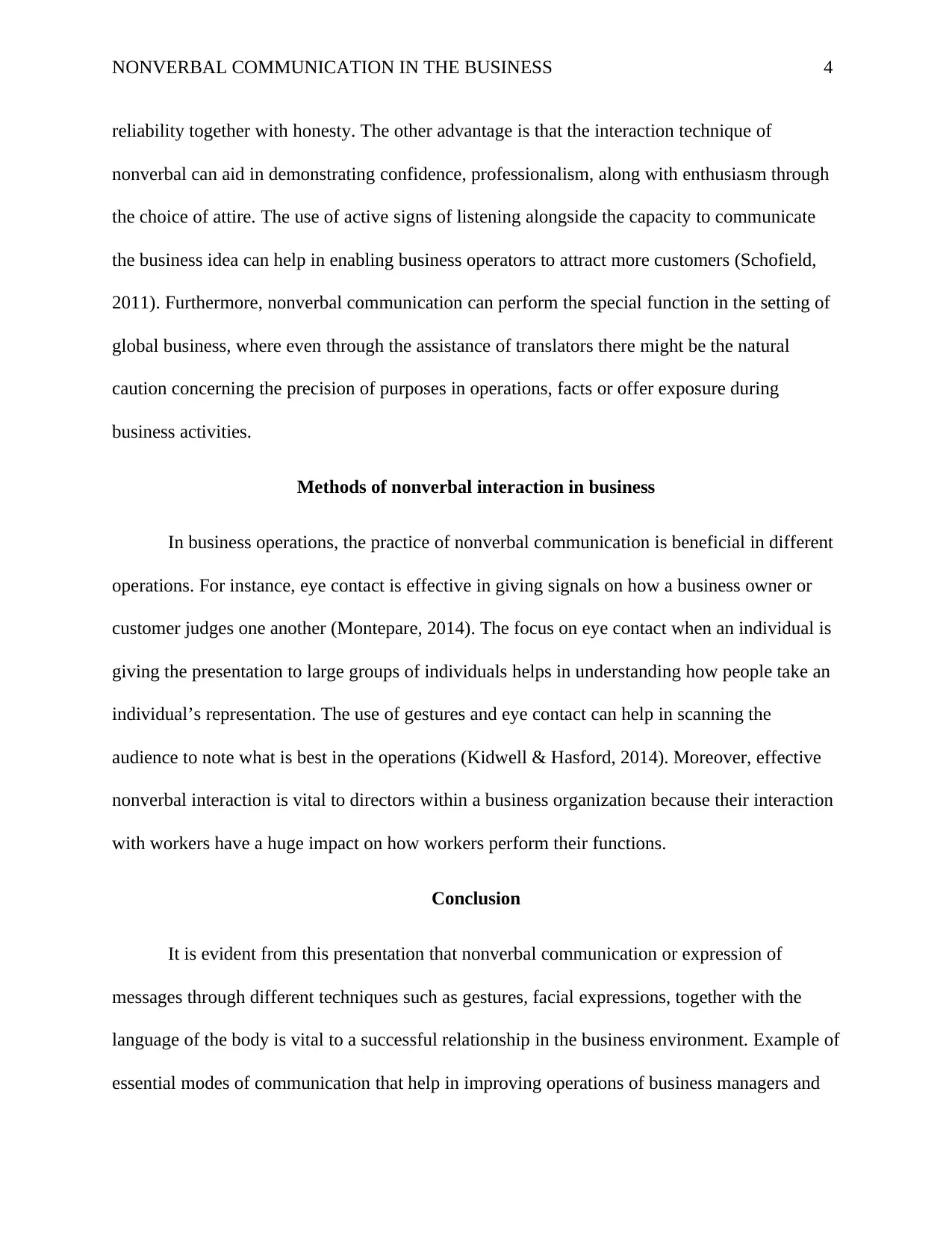
NONVERBAL COMMUNICATION IN THE BUSINESS 4
reliability together with honesty. The other advantage is that the interaction technique of
nonverbal can aid in demonstrating confidence, professionalism, along with enthusiasm through
the choice of attire. The use of active signs of listening alongside the capacity to communicate
the business idea can help in enabling business operators to attract more customers (Schofield,
2011). Furthermore, nonverbal communication can perform the special function in the setting of
global business, where even through the assistance of translators there might be the natural
caution concerning the precision of purposes in operations, facts or offer exposure during
business activities.
Methods of nonverbal interaction in business
In business operations, the practice of nonverbal communication is beneficial in different
operations. For instance, eye contact is effective in giving signals on how a business owner or
customer judges one another (Montepare, 2014). The focus on eye contact when an individual is
giving the presentation to large groups of individuals helps in understanding how people take an
individual’s representation. The use of gestures and eye contact can help in scanning the
audience to note what is best in the operations (Kidwell & Hasford, 2014). Moreover, effective
nonverbal interaction is vital to directors within a business organization because their interaction
with workers have a huge impact on how workers perform their functions.
Conclusion
It is evident from this presentation that nonverbal communication or expression of
messages through different techniques such as gestures, facial expressions, together with the
language of the body is vital to a successful relationship in the business environment. Example of
essential modes of communication that help in improving operations of business managers and
reliability together with honesty. The other advantage is that the interaction technique of
nonverbal can aid in demonstrating confidence, professionalism, along with enthusiasm through
the choice of attire. The use of active signs of listening alongside the capacity to communicate
the business idea can help in enabling business operators to attract more customers (Schofield,
2011). Furthermore, nonverbal communication can perform the special function in the setting of
global business, where even through the assistance of translators there might be the natural
caution concerning the precision of purposes in operations, facts or offer exposure during
business activities.
Methods of nonverbal interaction in business
In business operations, the practice of nonverbal communication is beneficial in different
operations. For instance, eye contact is effective in giving signals on how a business owner or
customer judges one another (Montepare, 2014). The focus on eye contact when an individual is
giving the presentation to large groups of individuals helps in understanding how people take an
individual’s representation. The use of gestures and eye contact can help in scanning the
audience to note what is best in the operations (Kidwell & Hasford, 2014). Moreover, effective
nonverbal interaction is vital to directors within a business organization because their interaction
with workers have a huge impact on how workers perform their functions.
Conclusion
It is evident from this presentation that nonverbal communication or expression of
messages through different techniques such as gestures, facial expressions, together with the
language of the body is vital to a successful relationship in the business environment. Example of
essential modes of communication that help in improving operations of business managers and
Paraphrase This Document
Need a fresh take? Get an instant paraphrase of this document with our AI Paraphraser
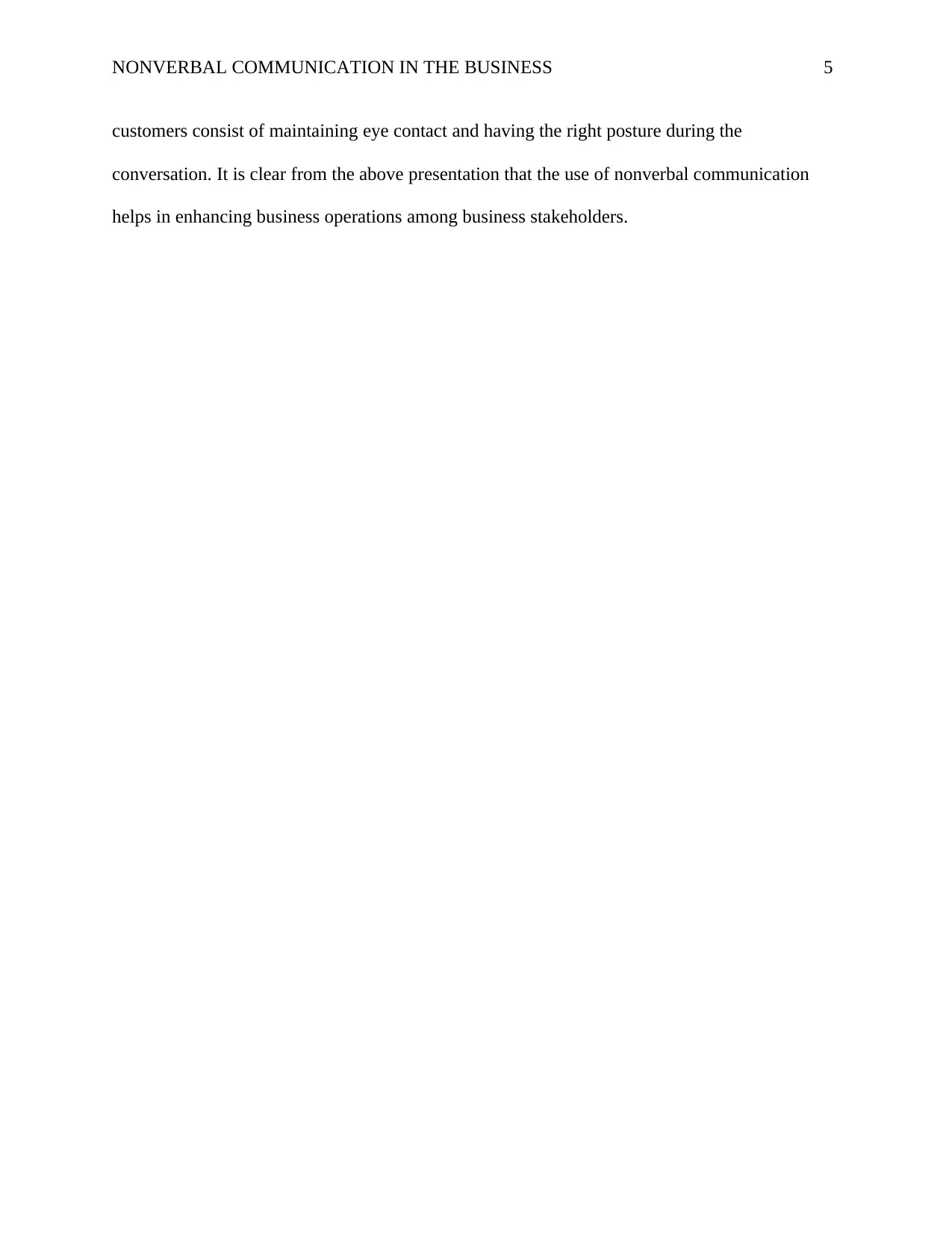
NONVERBAL COMMUNICATION IN THE BUSINESS 5
customers consist of maintaining eye contact and having the right posture during the
conversation. It is clear from the above presentation that the use of nonverbal communication
helps in enhancing business operations among business stakeholders.
customers consist of maintaining eye contact and having the right posture during the
conversation. It is clear from the above presentation that the use of nonverbal communication
helps in enhancing business operations among business stakeholders.
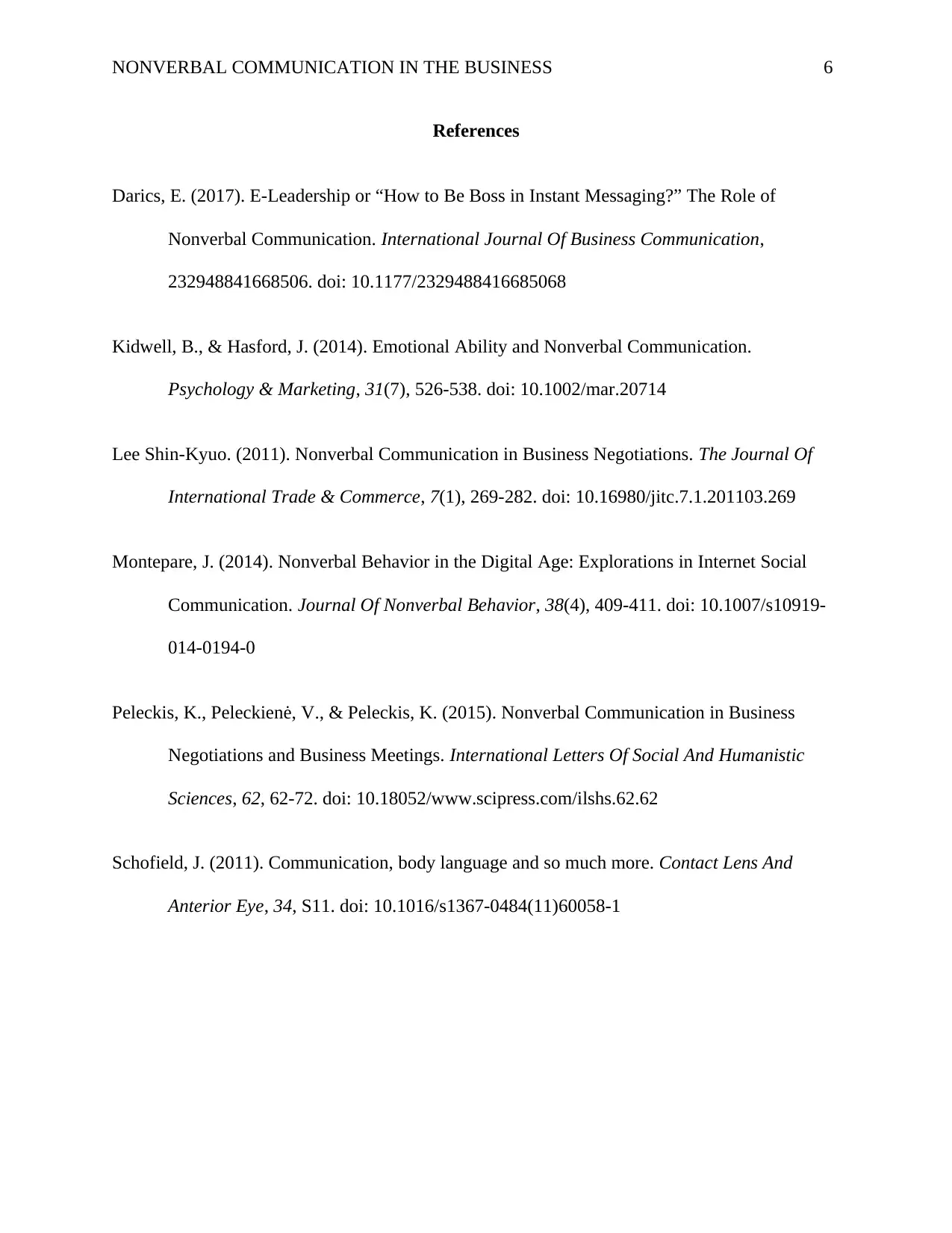
NONVERBAL COMMUNICATION IN THE BUSINESS 6
References
Darics, E. (2017). E-Leadership or “How to Be Boss in Instant Messaging?” The Role of
Nonverbal Communication. International Journal Of Business Communication,
232948841668506. doi: 10.1177/2329488416685068
Kidwell, B., & Hasford, J. (2014). Emotional Ability and Nonverbal Communication.
Psychology & Marketing, 31(7), 526-538. doi: 10.1002/mar.20714
Lee Shin-Kyuo. (2011). Nonverbal Communication in Business Negotiations. The Journal Of
International Trade & Commerce, 7(1), 269-282. doi: 10.16980/jitc.7.1.201103.269
Montepare, J. (2014). Nonverbal Behavior in the Digital Age: Explorations in Internet Social
Communication. Journal Of Nonverbal Behavior, 38(4), 409-411. doi: 10.1007/s10919-
014-0194-0
Peleckis, K., Peleckienė, V., & Peleckis, K. (2015). Nonverbal Communication in Business
Negotiations and Business Meetings. International Letters Of Social And Humanistic
Sciences, 62, 62-72. doi: 10.18052/www.scipress.com/ilshs.62.62
Schofield, J. (2011). Communication, body language and so much more. Contact Lens And
Anterior Eye, 34, S11. doi: 10.1016/s1367-0484(11)60058-1
References
Darics, E. (2017). E-Leadership or “How to Be Boss in Instant Messaging?” The Role of
Nonverbal Communication. International Journal Of Business Communication,
232948841668506. doi: 10.1177/2329488416685068
Kidwell, B., & Hasford, J. (2014). Emotional Ability and Nonverbal Communication.
Psychology & Marketing, 31(7), 526-538. doi: 10.1002/mar.20714
Lee Shin-Kyuo. (2011). Nonverbal Communication in Business Negotiations. The Journal Of
International Trade & Commerce, 7(1), 269-282. doi: 10.16980/jitc.7.1.201103.269
Montepare, J. (2014). Nonverbal Behavior in the Digital Age: Explorations in Internet Social
Communication. Journal Of Nonverbal Behavior, 38(4), 409-411. doi: 10.1007/s10919-
014-0194-0
Peleckis, K., Peleckienė, V., & Peleckis, K. (2015). Nonverbal Communication in Business
Negotiations and Business Meetings. International Letters Of Social And Humanistic
Sciences, 62, 62-72. doi: 10.18052/www.scipress.com/ilshs.62.62
Schofield, J. (2011). Communication, body language and so much more. Contact Lens And
Anterior Eye, 34, S11. doi: 10.1016/s1367-0484(11)60058-1
⊘ This is a preview!⊘
Do you want full access?
Subscribe today to unlock all pages.

Trusted by 1+ million students worldwide
1 out of 6
Related Documents
Your All-in-One AI-Powered Toolkit for Academic Success.
+13062052269
info@desklib.com
Available 24*7 on WhatsApp / Email
![[object Object]](/_next/static/media/star-bottom.7253800d.svg)
Unlock your academic potential
Copyright © 2020–2025 A2Z Services. All Rights Reserved. Developed and managed by ZUCOL.





